Ceylon
|
On the morning of January 8th, we left Port Blair in the Andaman Islands, with only a small bureaucratic hiccough, and headed south and then west to clear the islands before dark. We again encountered quite turbulent seas as we passed through the islands, but by 4 pm the log notes
"mainsail down, twin headsails up : delightful!" For the first time since we left Australia, we had reliable enough winds to let Cecile steer the boat with the windvane alone, with no assistance from the electronic autopilot which, in light winds or when motoring, we use in conjunction with her. (For the sailors among you, you attach a very small autopilot to the steering oar, so that you get the steering power from the oar, but the direction from the autopilot instead of the wind vane.)
It was lovely to be back in the trade winds again, with the wind relatively constant, occasionally changing speed or direction very slightly, so that the sails only needed few and minor adjustments. Thus we rolled along across a very blue sea, with the thermometer at about 80°F, flying fish on the deck every morning and would have been happy for the passage to last for ever!
|
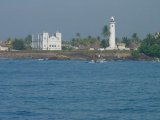
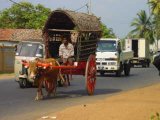
|
The approach to Galle gives some indication of the attractive colonial town which remains, which we spent a small amount of time exploring before hiring a small minibus (apparently the only form of transport in
Galle) with driver to explore more of the country. Other yachtsmen had advised taking a driver instead of driving car oneself, which we did in the end mainly because of the need to go up to Colombo to hire a car and get a local licence, but the local driving was indeed interesting
: though we didn't see any accidents. Galle still retains its old fort, many sea captains' and merchants' houses from both Dutch and British colonists, and although visited by tourists, retains its local character, with tuk-tuk taxis (small cabs on three wheeled scooters), bullock carts, street markets and a Post Office where one glues stamps onto envelopes using the glue pot and brush provided.
|
One magnificently sited old sea captain's house, now the Closenberg Hotel, had a lovely garden for dinner, from where one looked down over the bay next to the harbour, full of fishing boats with their fires, and where flying foxes came in to roost in the trees just below us on the cliff and fireflies hovered round the table.
Ceylon is a country of enormous diversity : from jungle to the high country to dry scrubby bush in the south east - which makes it very interesting. We had observed that many banks and other companies retain
"Ceylon" in their names, and found that though "Lanka" has always been the Sinhalese name for the country, the ordinary people were not particularly motivated to change the name and seemed quite happy to have their country called Ceylon.
|
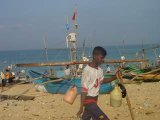
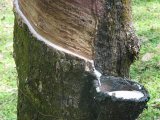
|
On our first day out of
Galle, we saw fishermen landing their small often very mixed catches and auctioning them
individually; coconut trees with interconnecting ropes between the tops of the
trees to make life easier for the toddy tappers who tap the coconut buds, collecting sap to turn into syrup and to distil into arrack; extensive rubber plantations,
which with their painstaking manual work and relatively small yields, clearly demonstrated the need to find alternative materials to natural rubber; gem mines
with their deep, dark and dangerous pit shafts and tunnels, where water is constantly pumped out to allow the soil to be dug out, hauled up and panned; and the much cooler temperatures and spectacular scenery in the tea plantations, from our cottage in one of them.
|
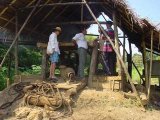
|
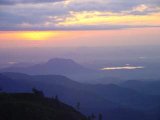
|
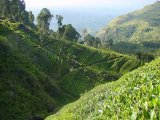
|
We were lucky to find, almost by chance, these delightful cottages on a plantation, each one with its own dining room where dinner and breakfast were served, and sitting room with fireplace. It would be a lovely place to spend a few days, but we just had time for one night there. The cottages led us to experience one of the most beautiful and dramatic drives and views of our time in Sri Lanka
: up to what is known as Lipton's Seat, where Thomas Lipton was said to go to meditate. The drive up through one of the highest tea gardens in Sri Lanka
was on 10 kilometres of rather rough track and our driver got very nervous and truculent about the damage he feared for his master's van. He asked us to take responsibility for any damage caused, which we did, then we alternatively coaxed and bullied him for most of the way (he refused to let John do the driving!). As we neared the top, he said
"Ma'am, can you smell something?" to Helen who was sitting in the front, and, thinking we were going to hear about a problem with the brake pads or something, she ignored him. But he persisted
- "Ma'am, I think I can smell heaven!" (he was a Catholic). Afterwards, he said he would definitely recommend Lipton's Seat to other tourists, but would refuse to drive them himself!
|
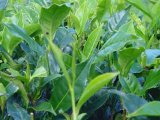
|
We still had a little walking to do, through the tea bushes
and past the pluckers, to reach the top, which was above the clouds. Visiting our first tea factory was less of an encouragement to drink tea, but we found a second, at which they seemed to produce tea which might not all have been used in the nastiest tea bags!
|
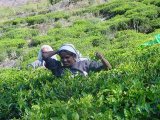
|

|
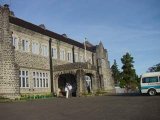
|
We spent our second night in Nuwara Eliya, known as Little England for the number of English who had made their homes there, and live there to this day. The Anglican church there had interesting memorials around its walls and, having just completed a successful appeal for funds was in beautifully kept condition, in rather sad contrast with the very dilapidated state of the church building in
Galle. Unfortunately we were in neither place at the right time to attend a service. We stayed at the Hill Club,
with its avuncular elderly club servants; and whose rules insist on jacket and tie for men in the dining room (women are allowed in) which is lined with antlers; whose corridors are lined with stuffed trout and hunting prints; whose fresh flower arrangements would put many a church to shame, and which has a chamber pot, only withdrawn from service in the club bedrooms in 1967, in a glass display cabinet at the top of the stairs. Perhaps the ultimate luxury was that, as we were getting ready for bed, proper hot-water bottles were brought up to our rooms (it was cold at night that high!). The public parts of Nuwara Eliya are now very much less attractive than
Galle, so we moved quickly on to Kandy the following morning.
|
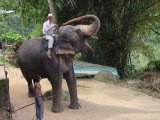
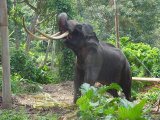
|
There we visited and rode
some elderly elephants by the river. They were accustomed to being fed chunks of sugar cane by their riders, and eagerly stretched out their trunks for their goodies. Riding bareback was surprisingly comfortable (we didn't go far), though slightly alarming as one got going down hill towards the river. We had learnt that in Thailand, a young elephant is given two mahouts who train him together
: an older man and a young one, so that between them they should last out its life. Here, the handover period between mahouts (one per elephant) is reckoned to be at least a month, there being 26 commands that an elephant is trained to.
"Our" elephants had among their number a tusker (fairly rare among Asian elephants
: only about 4% of all bulls) who was in the middle of his sexual period, which lasts for three months out of every 12. At 60 years old, he was regarded as extremely dangerous, was tethered by all four legs under a sun shade, and was being hosed down by his mahout, as he couldn't be allowed to move into the river. It is difficult to find a mate, as the gestation period is 22 months, during which the cow cannot work, so owners are quite reluctant.
|
We were amused later in the centre of Kandy to see a young tusker being led around the temple precincts with his mahout carrying a large load of palm leaves for his lunch (we had seen several elephants on the road carrying their own lunch, which is huge). The temples very much prize elephants, and particularly tuskers, for participation in ceremonies and rituals
: the ones we had ridden had been hired out to a temple 200 kilometres away for a ceremony!
|
|
|
Kandy itself was an attractive town (Sri_Lanka_22), with its old palace and lake, and was as far north as we went. Perhaps because we didn't visit the ancient ceremonial sites, we didn't really ever get to grips with Ceylon's pre-colonial history. We found the Temple of the Tooth in Kandy a little baffling (it is said that a relic of the Lord Buddha - his tooth - is kept in the inner sanctuary of the temple, though it is never seen by normal members of the public.) It has enormous significance in Sri Lanka and Buddhists flock from all over the country to worship/pray at the temple.
|
In the nearby museum, it was clear that the British administration had recognised, finally, the importance to the local population of the Tooth, and had fostered the traditional ceremonies and parades associated with it, to good effect on their rule. The museum was interesting but, as so often, poorly lit and annotated. (We have identified a huge scope for a first-world-run charity to enhance
"inter-cultural understanding" by adopting third world museums and simply making the notes legible, lighting the displays, and ensuring a constant supply of light bulbs - no smart designs required till all that is done, which is no mean feat, if our experience is anything to go by.)
The British, as colonists after the Portugese and then the Dutch, were able to take over this, the last inaccessible and independent area of the country when the extravagant and vicious king of Kandy was betrayed by his nobles to the British, to save the people from the King's worst excesses. The treaty, on display in the museum, and including effectively a bill of rights - to justice, a fair hearing, etc - is fascinating to read. Before that, colonists had really only been interested in the coastal areas and ports. Subsequently it was the British who first tried to grow coffee, unsuccessfully, in the hills and then introduced both tea and rubber, both as we understand it, using stolen cuttings and seeds from China and Brazil respectively.
|
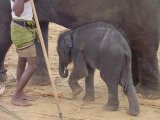
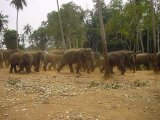
|
We paid the statutory visit to the Pinnawela elephants' orphanage, which was very entertaining. The orphanage has been very successful not only in rescuing elephants, but in breeding from them, so that there are all sizes from 2 month old calves to some quite sizeable bulls. The elephants are semi wild
: there are 5 mahouts for about 70 elephants who, for example drive them down to the nearby river twice a day for two hours each to bathe and frolic. One or two are trained to work in the orphanage, hauling food around for the other elephants. Although one is kept at a
"safe" distance from most of the elephants, it is an extraordinary feeling to be so close to such large mammals.
|
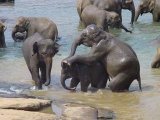
|
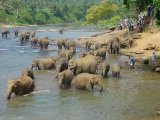
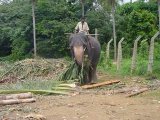
|
The countryside in Sri Lanka was a great contrast to the Andamans in the style of its working, with signs of great industriousness - immaculate fields of vegetables up near Nuwara Eliya and of course the manicured look of the tea gardens. The verges are neatly trimmed, by hand, with small scythes rather like golf clubs both in their shape and action. We were amused to see how many private houses' paintwork was maintained by the soap companies, who use one prominent wall to paint a huge advert for their brand, in return for painting the rest of the house. We passed a number of houses which seemed to have scarecrow-type dummies tied to the front wall. We had a slightly incoherent explanation from our driver, from which we understood that it is believed to be bad luck to have anyone look at or round a house while it is still under construction. The dummies are tied to unfinished houses in order to divert the attention of would-be visitors or curious passers-by away from the house itself!
Our driver regaled us with the saying that communism will never succeed in Sri Lanka
: because of its climate, everyone can find the means to feed himself and his family and to provide shelter. With breadfruit, jackfruit and manioc plentifully available, no-one will ever starve. It seems that there is enough land that anyone may claim an acre to cultivate and build a house, and once he can demonstrate that he is working the land, it becomes his. Many houses have their own wells for drinking water, though modern versions of hand pumps are also to be seen. Many villages near rivers or streams seem to have a public area for showering and washing clothes. There was plenty of evidence of weaving baskets and mats, from various palms and from pandanus, but there is clearly no
"mat culture" of the sort we met in so many Pacific islands.
As we drove down towards the dry south east, the landscape flattened and we found big irrigation channels to feed paddy fields and herds of water buffalo with their very pretty young calves (the ugly duckling in reverse). The irrigation channels ran along the roadside and there were log bridges across the 15 feet or so to the houses by the fields. Ladies in saris could be seen walking slowly but surely along the rounded top of a narrow log.
When we reached the drier parts, the housing materials changed from mainly breeze block walls and corrugated iron roofs to brick, rendered in clay and often roofed in woven palm leaves. Here we saw bundles of what looked like brown candy floss, which had been hand-processed from coconut husks and were waiting to be collected to go to the rope factory. The temperature rose again and the landscape became arid, with sand and scrub and a few low-growing trees.
|
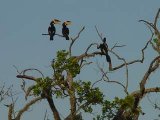
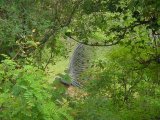
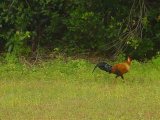
|
We were heading for Kuna Yala national park with its amazing bird life and the possibility of seeing wild elephant, leopard and some other smaller mammals. We rented a jeep with a driver and a guide, and had a wonderful few hours in the park. We saw several different sorts of bee eater, kingfisher, lapwing and heron, and we saw storks and spoonbill and hornbill (this is the Malabar pied hornbill), wild peacock, Sri Lanka's national bird, the jungle fowl
and many many others. As at Yellow Waters in Australia, one was so close to the birds, one could really watch them closely
: there was no need to be an expert to appreciate them! At one point we stopped with a couple of other jeeps which were listening for elephant in the bush. They carried on and we stayed for a few minutes, and then saw a large bull walking towards us. We were busy taking photos as it became apparent that he was going to walk straight past our open sided jeep. At this point both the driver and the guide said
"you must not move, you must not speak, you must do nothing at all to disturb him as he goes past", which is when you realise just how powerful and wild he is
: again a magnificent feeling. Finally as we drove back to the hotel at dusk, we spotted this water buffalo, nicely silhouetted against the sunset.
From the hotel, which was right on the beach, we were able to see the Great Barnes Lighthouse that we had sailed past 10 days earlier.
|
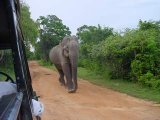
|
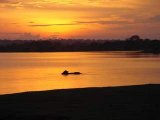
|
We had originally intended to spend 3 or 4 days ashore, but were so taken with the countryside that it was 6 days before we got back to the boat. It was time to start victualling and getting ready for the next shortish hop to the northern most atoll in the Maldives, right on the route to Oman, our next main stop. Part of the shopping included some handicraft shops in Galle, in one of which, when we asked if a carved elephant was really made of ebony, the assistant took a saw to the underside of its foot to prove the point!
Just before we left, we were delighted to meet Notre Dame, owned by Rob and Lynne, friends of friends, who we had been looking out for, and talking to on the radio, but not managed to meet. They are extreme representatives of the cruising community who sail en famille, with Katie, aged 2 ½, and Daniel, about to be 1. We met quite a lot of boats with children of varying ages and number, but Katie and Daniel together were the youngest
: it certainly must add a challenge to one's cruising life, but Rob and Lynne carry it off with great aplomb.
On 25th January, we left Galle, managing to keep the Navy off the boat altogether this time, and had to motor for the first 24 hours or so, in a flat calm. Ships often seem to appear only at night, and it was a busy first night, with a lot of shipping rounding Sri Lanka and heading to or from the Eight Degree channel between the Maldives and the Laccadives. When the wind did finally come up, it was from the north west, though light, so we were able to head into it and make reasonable progress under sail, but not quite in the right direction. We were hoping for a return of the south easterly trade winds to allow us to get back on track, but in the end used the windless periods to correct our track under motor instead.
|
The Maldives
We arrived in the huge Ihavandiffulu Atoll, dropping anchor off Ulegumu Island four days after leaving Galle. We had been told that the clearing in process was the smoothest ever, and shortly after we arrived, a motor boat appeared with the coastguard and customs on board, who cleared us in in less than 5 minutes, with no untoward requests
: a delightful change! We had decided to see if we could find a local or two who would like some work, namely swimming round the hull to scrub the barnacles off. (We did apply anti-fouling paint in Australia
: apparently we should have done it in Malaysia or Thailand, where you can buy seriously poisonous paint.) But almost the only rule here is that locals may not be invited on board the boat. However, the young coastguard officer said
"we will come and do it for you!" and in due course they did : three young men, on quite a rough and blustery day, spent a good hour scrubbing off the hull, for which they would accept no payment of any kind. They had to wait for a boat to collect them, and we managed to get them to accept a cup of tea to warm them up a little, and later were able to give some biscuits, dates and English books by way of thanks. But what a change!
This atoll has become a favourite stopping off point for yachts, as it is so close to the route to Salalah in Oman, which is the last port for civilised victualling until you are through the Red Sea. Therefore, although it has no electricity, other than a few private generators, some of the residents have learnt about and tuned in to the needs of yachtsmen, (there are no other tourists) so that one can now buy diesel, acquire drinking water, and a surprising variety of groceries and fruit as well as eggs on the island. Apart from their seasonal visitors though (the main west-bound season lasts for maybe three months), the islanders live a fairly traditional life.
|

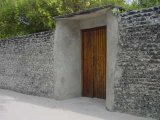
|
There is a small town of maybe 200 people, who seem to farm, fish and work for the government. The streets are of sand, but the houses are in the main solidly built, of coral, in walled compounds with rather elaborate gateways. A few families, such as this one are still building in what must be a traditional form, of stitched and woven palm leaves.
|
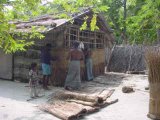
|
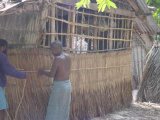
|
Trees grow surprisingly well, both inside and outside the compounds, each of which has its own well. The ones we saw were constructed with high parapets (very unlike the ones we saw in Vanuatu) and had clear water in them, with small fish swimming around in the bottom. When we were there, this was the drinking water for most houses, as it hadn't rained recently. Luckily the water table is quite high, though we gathered that the well water is slightly brackish. The drinking water offered to yachtsmen came from a huge butt in which rainwater must have been saved
: most houses have good rainwater collection systems.
Breadfruit grows copiously, as do bananas, and some other trees whose fruit was being collected by small children hitting the branches with sticks. We found the small hard fruit unpalatable, but they were clearly enjoyed by the locals.
|
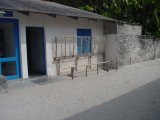
|
We were intrigued by the Maldivian armchairs which were to be found, often folded up outside each house, but sometimes arranged around a large flat raised platform made of logs which was not part of any compound. Here we would occasionally see a small group of people sitting, or sprawled on the platform, talking or relaxing. The pace of life is gentle
: one admittedly very hot morning, by mid morning several people seemed to be asleep on the platforms with their children.
|
|
|
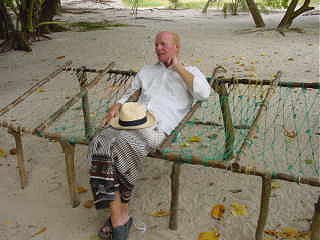
|

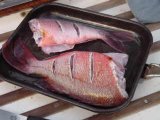
|
Fishing is carried out mainly using the traditional and powerful looking dorni, though we only saw one being sailed in the traditional manner
: most now seem to rely on their engines. Spear fishing is prohibited, and any yacht carrying one has it confiscated, but as we don't carry one anyway, that was no problem to us. But the fishing was excellent, and John spent several happy hours trolling for fish from the dinghy, with good results for dinner. The snorkelling was interesting - the coral has suffered a lot of die-back, possibly from global warming
: but the fish were splendid, and we were particularly intrigued to see sea cucumbers waving about, having only seen very static ones before.
|
We spent 5 days in the Maldives altogether, enjoying the gentle pace of life, although we once again enjoyed unusual weather
: blustery northerlies, which sent quite a big swell into the anchorage and made the dinghy work, fishing and swimming slightly less congenial than normal. On our last day, the wind dropped slightly and made the atoll its usual idyllic self!
The clearing out process was as simple as clearing in, and on our last morning the difficulties of trying to supply yachtsmen on such a small island were demonstrated when there were no bananas available and the bread had not arrived from the bakery on one of the other islands across the atoll! Luckily we were not dependent on either, and we set off for Salalah with a good north easterly breeze which had us racing along at 7 knots for the first few hours
: a really good start.
|